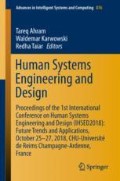Abstract
Existing usability testing methods using verbal reports and behavioural observations estimate the time consumed in different tasks and errors occurred therein etc., they fail to provide feedback on traits like attraction and excitement felt by users which is required for tourism websites to succeed. Thus there is a need to expand the usability parameters beyond cognitive measures like ease of use and efficiency etc. and into affective measures like attraction, enjoyment, excitement, etc. This study reports use of physiological measures within usability testing setup to measure affective parameters by means of galvanic skin response, eye tracker measures and behavioural responses. In light of the findings, this paper argues use of physiological measures as an objective, low cost and practical addition to usability testing practice to enrich the usability testing findings and pave way for website designers for affective improvements into their sites.
Access this chapter
Tax calculation will be finalised at checkout
Purchases are for personal use only
References
Hudlicka, E.: To feel or not to feel: the role of affect in human–computer interaction. Int. J. Hum.Comput. Stud. 59(1–2), 1–32 (2003)
Conati, C.: Probabilistic assessment of user’s emotions in educational games. Appl. Artif. Intell. 16, 555–575 (2002)
Norman, D.: Emotion & design: attractive things work better. Interactions 9, 36–42 (2002)
Duchowski, A.: Eye Tracking Methodology: Theory and Practice, vol. 373. Springer, London (2007)
Goldberg, J.H., Kotval, X.P.: Computer interface evaluation using eye movements: methods and constructs. Int. J. Ind. Ergon. 24(6), 631–645 (1999)
Ehmke, C., Wilson, S.: Identifying web usability problems from eye-tracking data. In: HCI 2007, pp. 119–128 (2007)
Fiedler, S., Glockner, A.: The dynamics of decision making in risky choice: an eye-tracking analysis: (519682015-072). PsycEXTRA Dataset. APA (2012)
Liversedge, S.P., Findlay, J.M.: Saccadic eye movements and cognition. Trends Cogn. Sci. 4(1), 6–14 (2000)
Goldberg, J.H., Stimson, M.J., Lewenstein, M., Scott, N., Wichansky, A.M.: Eye tracking in web search tasks: design implications. In: Proceedings of the Symposium on Eye Tracking Research & Applications, ETRA 2002, pp. 51–58 (2002)
Phillips, M.H., Edelman, J.A.: The dependence of visual scanning performance on search direction and difficulty. Vis. Res. 48(21), 2184–2192 (2008)
Boehm-Davis, D.A., Gray, W.D., Schoelles, M.J.: The eye blink as a physiological indicator of cognitive workload. In: Proceedings of the Human Factors and Ergonomics Society Annual Meeting, vol. 44, no. 33, July 2000
Siegle, G.J., Ichikawa, N., Steinhauer, S.: Blink before and after you think: blinks occur prior to and following cognitive load indexed by pupillary responses. Psychophysiology 45(5), 679–687 (2008)
Jacob, R.J.K., Karn, K.S.: Eye tracking in human-computer interaction and usability research. In: The Mind’s Eye, pp. 573–605. Elsevier (2003)
Nourbakhsh, N., Wang, Y., Chen, F., Calvo, R.A.: Using galvanic skin response for cognitive load measurement in arithmetic and reading tasks. In: Proceedings of the 24th Australian Computer-Human Interaction Conference on, OzCHI 2012, pp. 420–423 (2012)
Lykken, D.T., Venables, P.H.: Direct measurement of skin conductance: a proposal for standardization. Psychophysiology 8(5), 656–672 (1971)
Mehler, B., Reimer, B., Coughlin, J.F., Dusek, J.A.: Impact of incremental increases in cognitive workload on physiological arousal and performance in young adult drivers. Transp. Res. Rec. J. Transp. Res. Board 2138(1), 6–12 (2009)
Kahneman, D.: Experienced utility and objective happiness: a moment-based approach. In: Choices, Values and Frames, pp. 673–692 (2000)
Author information
Authors and Affiliations
Corresponding author
Editor information
Editors and Affiliations
Rights and permissions
Copyright information
© 2019 Springer Nature Switzerland AG
About this paper
Cite this paper
Kumar, J., Kumar, J. (2019). Investigation of Usability Issues Through Physiological Tools: An Experimental Study with Tourism Websites. In: Ahram, T., Karwowski, W., Taiar, R. (eds) Human Systems Engineering and Design. IHSED 2018. Advances in Intelligent Systems and Computing, vol 876. Springer, Cham. https://doi.org/10.1007/978-3-030-02053-8_56
Download citation
DOI: https://doi.org/10.1007/978-3-030-02053-8_56
Published:
Publisher Name: Springer, Cham
Print ISBN: 978-3-030-02052-1
Online ISBN: 978-3-030-02053-8
eBook Packages: Intelligent Technologies and RoboticsIntelligent Technologies and Robotics (R0)

